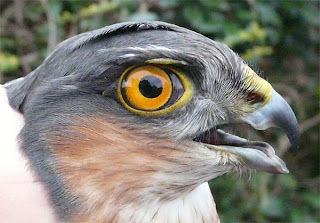After being confined to the house for the usual Christmas day celebrations, I was itching to get out into the fresh air, so decided to put a net up in the garden. No sooner had I put it up and the resident Sparrowhawk decided to fly through the garden and straight into my net. I had been watching this bird over the last couple of days and assumed it to be the same bird as last winter, because it was following exactly the same route as that bird...however that proved not to be the case as that bird was an adult!
 |
| Male Sparrowhawk |
To the uninitiated catching a Sparrowhawk can be a very painful experience, it is not the sharp hooked bill that you need to be aware of, but the even sharper and extremely strong talons. I have been bloodied by Sparrowhawks on many occasions, but luckily not today.
 |
| Male Sparrowhawk |
Sparrowhawks can be sexed by their size, since there is significant sexual size dimorphism in the species, with males being much smaller. Based on this birds small size and partly slate grey coloured mantle, wing and tail feathers, it was immediately evident that it was a male. In confirmation of this it had a wing length of 198mm, which is well short of the 222-256mm range usually expected in females.
 |
| Wing of Sparrowhawk showing two generations of feathers |
Aging male Sparrowhawks is generally quite straight forward, with first winter birds having dark brown upper parts that are fringed with chestnut and the underparts have bold heart shaped brown markings. The iris is grey-olive in colour. Second winter birds have a more adult type plumage, with mainly slate grey upper parts but occasional chestnut fringed feathers present and some retained juvenile tail feathers. In addition the iris is lemon to bright yellow, sometimes with an orange tinge.
 |
| Sparrowhawk tail showing mixture of adult and juvenile feathers |
The retained juvenile feathers in the tail were very apparent on this bird and orange tinge to the iris (see pics above) confirmed this bird as a second calender year male (or age code 5).
 |
| Robin |
Both birds were first winter birds, which was evident by the retention of four juvenile greater coverts (see below). These had large pale thorns at the tip, and there was an obvious break between the old juvenile feathers and where the new adult feathers started.
 |
| Wing showing retained juvenile greater coverts |
One bird had also moulted two tail feathers and therefore it was possible to see the comparison between worn and pointed juvenile tail feathers and fresh and rounded adult feathers.
 |
| Tail showing moulted adult central tail feathers and retained juvenile feathers (the rest) |
I have caught 11 different Robins in the garden this year, two of which were retraps from last year. This total is way down on last year when 23 different birds were captured, with 50% of those coming into the garden following the arrival of the extreme cold weather.
No comments:
Post a Comment